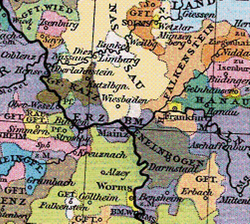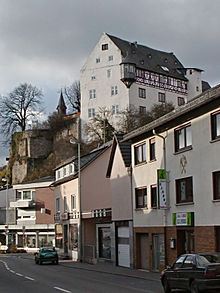- County of Katzenelnbogen
-
County of Katzenelnbogen
Grafschaft KatzenelnbogenState of the Holy Roman Empire ← 
1095–1479  →
→Coat of arms
The County of Katzenelnbogen (in dark gray)
and surrounding principalities in 1400Capital Katzenelnbogen Religion Roman Catholicism Government Principality Count - 1095 (first) Dieter I - 1444–79 (last) Philip I Historical era Middle Ages - First mentioned 1095 - County 1138 - Comital line extinct,
to Hesse-Marburg1479 The County of Katzenelnbogen (named after Chatti Melibokus) was an immediate state of the Holy Roman Empire. It existed between 1095 and 1479, when it was inherited by the Landgraves of Hesse.
The estate comprised two separate territories. The main parts were the original Untergrafschaft ("lower county") with its capital at Katzenelnbogen in the Middle Rhine area and the Obergrafschaft ("upper county") south of the Main river around Darmstadt, predecessor of the Landgraviate of Hesse-Darmstadt.
History
One Diether I of Katzenelnbogen (c. 1065–95), then serving as Vogt of Prüm Abbey, was first mentioned about 1070 in a deed issued by Archbishop Anno II of Cologne. From 1094 onwards Diether and his son Henry I built Katzenelnbogen Castle in the Taunus mountain range, in 1138 King Conrad III of Germany vested his grandson Henry II with the comital title, when the Kraichgau was bequested to him. The counts also built Burg Rheinfels and Auerbach Castle in the 13th century and finished Burg Katz in 1371, they rebuilt the Marksburg purchased from the Lords of Eppstein and acquired highly lucrative customs rights on the Rhine river. In almost four centuries the county grew bit by bit, from the river Neckar to the river Moselle.
The counts founded many cities and for centuries or decades they owned others like Offenbach, Gießen, Diez and Limburg. They also contributed to the enlargement of Eberbach Abbey, which became their family tomb in the 14th century. After the early death of Count Philipp's only son in 1453 he called himself Count of Katzenelnbogen-Diez. When Philipp died in 1479, the male line of the Katzenelnbogens became extinct. The "Obergrafschaft" was passed to the Landgraves of Hesse by virtue of the 1458 marriage of Henry III of Upper Hesse to Count Philipp's daughter Anna of Katzenelnbogen. Thereafter, the Landgraves of Hesse added to their title "Count of Katzenelnbogen".
History of wine
In 1435 Count John IV of Katzenelnbogen was building his last castle in Rüsselsheim where he ordered that the famous Riesling variety should be grown. This is the first documentation of the grape in history. There are hundreds of documented vineyards many of which still exist: among them the famous rock Loreley documented in 1395.
External links
Categories:- Former principalities
- Former countries in Europe
- States of the Holy Roman Empire
- States and territories established in 1095
- States and territories disestablished in 1479
- 1479 disestablishments
- Counties of the Holy Roman Empire
- History of the Rhineland
- History of Rhineland-Palatinate
- History of Hesse
Wikimedia Foundation. 2010.



